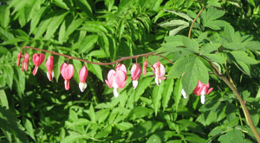The best way to prevent crop damage by deer is to plant deer-resistant flowering plants. These are plants that deer don't eat. The following article provides information on different deer-proof flowers with their characteristics.

The problem of pests like deer, which destroy your property, is quite serious in some parts of America. One of the options to tackle this problem is to grow flowering plants that deer resist. Here is a list of deer-resistant flowers that are easy to care for, and suitable for growing in a flower garden at home.
Ornamental Catmint
This plant produces purple-colored flowers with a strong scent. Its leaves are grayish-green in color, and possess a rough texture. This flowering plant flourishes in hardiness zones of 3 - 8. Well-drained soil is needed for its healthy growth. In a list published by Rutgers University, the Ornamental Catmint is rated as 'rarely damaged' with respect to deer.
Bleeding Heart
This is a perennial plant which prefers moist soil and a shady environment. Flowers produced by this plant are heart-shaped and pink in color. Another characteristic of the flowers is that they are droopy. This plant produces a lacy foliage, and can be grown in gardens/places with a shady surrounding and moist soil.
Monkshood
The yellow and white are commonly observed colors in flowers of Monkshood. This flower gets its name from the spikes which consist of hoods. The flowers, as well as other parts of this plant are poisonous. This plant blooms in summer, as well as fall. The hardiness zones of 3 - 6 are considered to be suitable for growing this plant.
Primrose (Primula)
This plant is used in lining borders, as space-fillers in gardens and also for container gardening. The 24 genera of flowering plants which belong to the
Primulaceae family are commonly referred as primrose. It is a bedding plant that produces flowers throughout summer. Caring for this plant is easy in comparison to other plants.
Russian Sage
It is amongst the important flowering plants used as a deterrent for deer. This flower has a distinct aroma and its leaves are silver in color. The flowering season of this plant starts in July and continues through till August. The number of flowers produced reduce in the month of September. Dry and sunny locations are suitable for growing this plant. It can be grown in hardiness zones of 4 - 9.
Coreopsis Moonbeam
Just like Ornamental Catmint, this plant is rated as 'rarely damaged' by the Rutgers University. It is commonly used for the purpose of gardening. It grows well in bright sunlight, and flowering starts in the month of June. The hardiness zones from 3 - 9 are suitable for growing this plant.
Peony (Paeonia)
The peony plant produces ruffled and large flowers. The flowering-season of peony is summer. This plant is quite popular and preferred by people interested in home gardening. The peony plant grows well in bright sunlight. Areas of the garden which receive enough sunlight should therefore be chosen for growing peony.
Lily of the Valley
This plant produces white, fragrant flowers. Spring is the flowering season of this plant. Shady areas are suitable for the growth of this plant. The flowers, along with other parts of this plant are toxic and therefore, deer do not feed on them. It is the responsibility of owners to keep the pets from eating them.
Growing these shrubs in the surroundings should keep the pests, especially deer away from the gardens.






 The problem of pests like deer, which destroy your property, is quite serious in some parts of America. One of the options to tackle this problem is to grow flowering plants that deer resist. Here is a list of deer-resistant flowers that are easy to care for, and suitable for growing in a flower garden at home.
The problem of pests like deer, which destroy your property, is quite serious in some parts of America. One of the options to tackle this problem is to grow flowering plants that deer resist. Here is a list of deer-resistant flowers that are easy to care for, and suitable for growing in a flower garden at home.